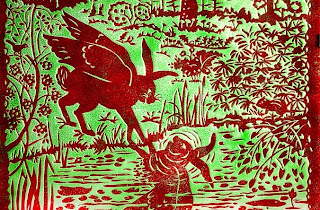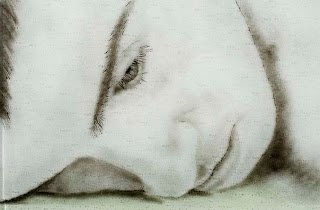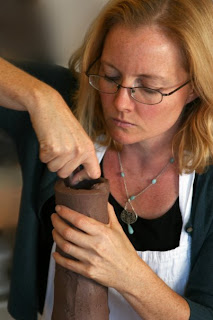>Craft committed suicide, but it was under the influence of art.
The victim pulled the trigger on itself, detective Garth Clark says, but it was under the influence of Art.
That’s Art, no last name, sometimes known as Fine Art. And though the corpse keeps getting tricked out for public events like the stiff in the movie comedy Weekend at Bernie’s, the actual time of death was, oh, somewhere around 1995.

Garth Clark
This was the premise of a fantastic and provocative lecture that was held at Portland‘s Museum of Contemporary Craft last October titled “How Envy Killed the Craft – An Autopsy in 2 parts”, given by Garth Clark – a leading international writer on modern and contemporary crafts today. In the talk Clark dryly assessed the current state of American Craft, and conducted an examination of how aesthetics, economics and art-envy have “killed” this 20th century movement. The talk is available online as a podcast from the museum – the details are at the end of this posting.
What is this art envy? Good question.
Surely it has something to do with money. Clark quoted one excellent potter of his acquaintance who says he and his friends have a word for potters who make a living entirely from their craft. It’s unicorns, “because we’ve never seen one.”
And surely it has something to do with reputation, with being taken seriously. Artists are simply thought of more highly, as more creative beings, more intellectual, and therefore more important (and, let’s underscore, more worthy of high prices in exchange for their work).
Perhaps it has something to do with escaping an eternal past. “Craft has been overdosing on nostalgia,” Clark averred. “This is craft’s Achilles heel.” That’s not surprising, he added, since the modern movement (which he stretches back 150 years, a very long time for a movement of any sort) was born as a revival, and thus looking backwards from its beginning.
So, he said, somewhere around 1980 craftmakers simply started referring to what they did as art. Museums and other organizations began to drop the word “craft” from their names — sort of like snipping their horse-thieving uncle from the family tree. For a few genuine artists who were trapped by their association with craft — people like Jun Kaneko and Robert Arneson – it was an escape with just cause. For others, it was wishful thinking. “Craft was strongly and sometimes pretentiously influenced by fine art,” Clark said, “but it did not cross the line to become fine art.”
What did Clark mean by “craft,” anyway? One object-maker drew applause when she commented that, when she’s in the studio, she doesn’t even think about whether she’s making art or craft, she just thinks about what she’s working on. And there was some sentiment that Clark was making a fuss about something that was really just about words and categories, things that come after the fact. “Everything he’s saying is coming from a gallery owner’s point of view,” one member of the audience said.
And there might be some truth to that. Still, Clark insisted that categories are vital, and they are real. “Ultimately there is something called craft and there is something called art,” he said. “And there’s nothing wrong with that.”
What, then, is the difference? When it came right down to it, Clark had a tough time describing exactly what craft is. And in a sense, he blamed that on craftmakers, because they themselves had abandoned the word. After that, he said, “It was almost impossible to write honestly about a field that pretended to be something else.”
And craft’s stress on physicality, Clark said, is “part of its problem as art goes to multimedia, using all sorts of things.” In other words, while craft is reaching toward art, art is reaching toward craft — toward an acceptance of all sorts of materials as viable raw material for the making of fine art.
Then again, he says, fine art’s embrace of traditional craft materials has more to do with “postmodernism’s promiscuity” — hardly a marriage of minds. And, he pointed out, in the mid-20th century fine art underwent a more than equal and opposite reaction, “away from craft-based values” and toward conceptualism — a conspicuously idea-driven form of art (even if the ideas are sometimes half-baked) that gets big media play even as it often rejects the entire concept of craftsmanship as old-fashioned and irrelevant. No wonder crafters feel a little loss of self-esteem.
Still, the question remains: What do we mean when we say “craft”? Maybe it’s a little like U.S. Supreme Court Justice Potter Stewart’s 1964 dictum on pornography: “I know it when I see it.” The borders are fuzzy, and that’s not necessarily a bad thing.
One man in the audience last night asked Clark whether we were using “craft” as a noun when we should be using it as a verb. Maybe so.
Either way, there’s something physical about the thing. “Craft is at its best when it is dealing with sensuality,” Clark said. “… (I)t grabs you by the throat and just thrills you.”
So maybe the more interesting question is, What is the relationship between art and craft? Does art require craft? If not, has the art world suffered for its loss? Clark says fine art doesn’t need craft. You can make great art without craft, he said, but you can’t make great craft without great skill. This is a far more significant question than many people in the art world will admit. For all of its history, from cave paintings on, art and craftsmanship have been intertwined. At what cost are they separated, if indeed they are?
For the 2-part podcast click HERE and scroll down to 10.16.2008 CraftPerspectives Lecture Garth Clark (Part 1 & 2)




